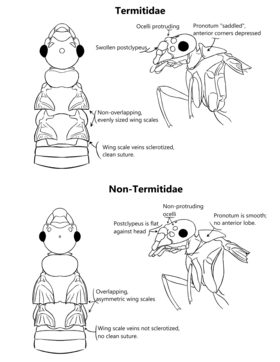Biology:Termitidae
| Termitidae | |
|---|---|

| |
| Nanotermes isaacae in Cambay amber. | |
| Scientific classification | |
| Domain: | Eukaryota |
| Kingdom: | Animalia |
| Phylum: | Arthropoda |
| Class: | Insecta |
| Order: | Blattodea |
| Infraorder: | Isoptera |
| Nanorder: | Neoisoptera |
| Family: | Termitidae Latreille, 1802 |
| Subfamilies | |
|
See text | |
Termitidae is the largest family of termites consisting of 2,105 described species of which are commonly known as the higher termites.[1] They are evolutionarily the most specialised termite group, with their highly compartmentalized hindgut lacking the flagellated protozoans common to "lower termites", which are instead replaced by bacteria. Whereas lower termites are restricted mostly to woody tissue, higher termites have diverse diets consisting of wood, grass, leaf litter, fungi, lichen, faeces, humus and soil.[2][3] Around 60% of species rely on soil-feeding alone.[4]
Subfamilies
The family contains the following subfamilies:[5]
- Termitidae Latreille, 1802
- Subfamily Apicotermitinae Grassé & Noirot, 1954 [1955] (synonym: Indotermitidae Roonwal & Sen Sarma in Roonwal, 1958)
- Subfamily Cubitermitinae Weidner, 1956
- Subfamily Foraminitermitinae Holmgren, 1912 (synonym: Pseudomicrotermitinae Holmgren, 1912)
- Subfamily Macrotermitinae Kemner, 1934, nomen protectum [ICZN 2003] (synonyms: Acanthotermitinae Sjöstedt, 1926, nomen rejiciendum [ICZN 2003]; Odontotermitini Weidner, 1956
- Subfamily Nasutitermitinae Hare, 1937
- Subfamily Sphaerotermitinae Engel & Krishna, 2004a
- Subfamily Syntermitinae Engel & Krishna, 2004a (synonym: Cornitermitinae Ensaf et al., 2004, nomen nudum)
- Subfamily Termitinae Latreille, 1802 (synonyms: Microcerotermitinae Holmgren, 1910b; Amitermitinae Kemner, 1934 (disputed); Mirocapritermitinae Kemner, 1934; Mirotermitini Weidner, 1956; Capritermitini Weidner, 1956)
Identification
Imago forewing and hindwing scales either evenly or closely sized and non-overlapping. Both forewing and hindwing scales have a developed suture with strongly sclerotized and reduced veins. Ocelli of imago typically (but not always) protruding above head capsule.
Pronotum of all castes is "saddled", with a pronounced anterior lobe as a result of the pronotum's anterior corners being depressed. Postclypeus of the worker and imago both swollen and protruding from head capsule
References
- ↑ Constantino, Reginaldo. "Termite Database". http://164.41.140.9/catal/statistics.php?filtro=extant.
- ↑ Ni, Jinfeng; Tokuda, Gaku (November 2013). "Lignocellulose-degrading enzymes from termites and their symbiotic microbiota". Biotechnology Advances 31 (6): 838–850. doi:10.1016/j.biotechadv.2013.04.005. ISSN 0734-9750. http://dx.doi.org/10.1016/j.biotechadv.2013.04.005.
- ↑ Breznak JA, Brune A. 1994. Role of microorganisms in the digestion of lignocellulose by termites. Annual Review of Entomology 39(1):453–487
- ↑ Josens, Guy; Makatia Wango, Solange (2019-02-01). "Niche Differentiation between Two Sympatric Cubitermes Species (Isoptera, Termitidae, Cubitermitinae) Revealed by Stable C and N Isotopes". Insects 10 (2): 38. doi:10.3390/insects10020038. ISSN 2075-4450. PMID 30717082.
- ↑ Engel, M.S. (2011). "Family-group names for termites (Isoptera), redux". ZooKeys (148): 171–184. doi:10.3897/zookeys.148.1682. PMID 22287896.
Wikidata ☰ Q1050699 entry
 |


